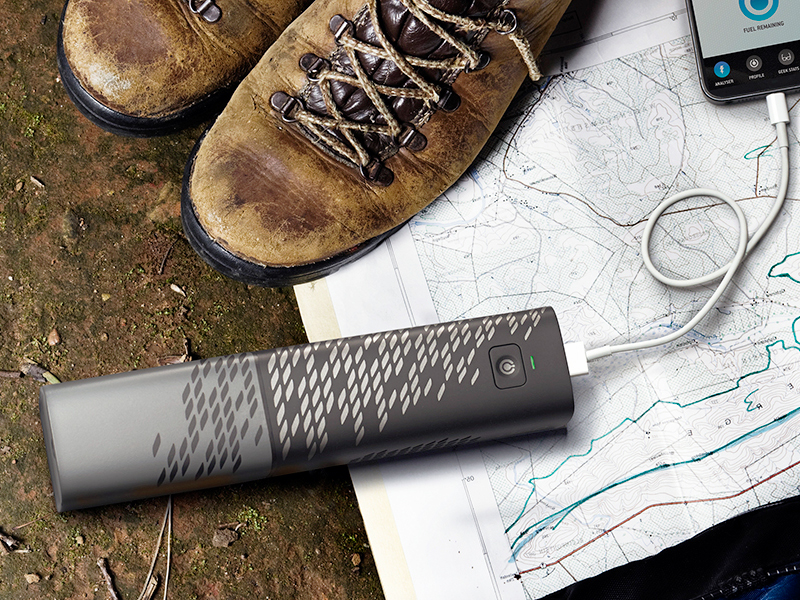Upp fuel cell review: Off-grid gadget power, at a price


The post-PC world is all about mobile technology, which means that people are increasingly concerned about keeping their various portable devices charged throughout the day. Most of the time, you'll be able to recharge your smartphone or tablet from a convenient source of mains power, but when you're properly off-grid, an alternative solution must be found. Many people carry a mains-rechargeable battery, and solar-powered chargers are also available. However, in areas where it's not feasible to use such devices, the Upp fuel cell is an interesting option. Developed by UK-based power technology specialist Intelligent Energy, the Upp was launched initially in Africa in November 2013, and is planned to be available worldwide in due course. In the UK, sales via the beupp.com store are expected to begin in June, where a fuel cell/fuel cartridge kit will cost £149 (inc. VAT).
How it works
The Upp is a PEM (Proton Exchange Membrane) fuel cell comprising two parts: the cartridge containing the hydrogen fuel, stored in high-density metal hydride form; and the fuel cell block containing stacked bipolar plates (combined anodes and cathodes) and fans to draw in air and expel the water vapour created by the electrochemical reaction between hydrogen and oxygen. The fuel cell block measures 119.5mm by 40mm by 48mm and weighs 235g, while the Upp cartridge is 29mm shorter at 90.5mm and 150g heavier at 385g. The two units snap together magnetically with a satisfying 'thunk' to form a device weighing 620g — something you'll definitely notice in your travel bag.
There's also a magnetic dust cap adapter for protecting the hydrogen inlet on the fuel cell when the two parts are disconnected (as they should be when the device is not in use). Some sort of tether for this dust cap might be an idea, as it could easily get misplaced or lost. The dust cap adapter also houses a Micro-USB port for charging the fuel cell's internal battery, should it become flat (after a prolonged period of storage, for example); this port is protected by a rubber plug, which is also untethered.
What can you charge with an Upp fuel cell? The brief answer is, anything you can charge via USB — there's a full-size USB Type A socket on the end of the fuel cell. In practice, that means feature phones, smartphones and iOS or Android tablets. According to the spec sheet, the 25Wh Upp fuel cell can fully charge a typical smartphone five times from a single cartridge. Tablets, which have bigger batteries, will generally only get one full charge from the device (the iPad Air, for example, has a 32.4Wh battery).
Upp in use
When you're ready to use the Upp device, you attach the two parts and press-and-hold the power button on the fuel cell portion for one second, whereupon, if all is well, a green LED should glow continuously. If it pulses green, the cartridge has less than 10 percent of its fuel remaining; a continuous amber glow means the Upp's firmware needs updating, while pulsing amber means the cartridge is out of fuel; anything red means you have a problem (continuous red for a cartridge authentication failure, pulsing red for an unrecognised firmware image).
According to Intelligent Energy, Upp charges as fast as the mains, and we found this to be a reasonable claim in our testing. Built-in battery protection software shuts down the Upp automatically once your battery is fully charged.
A key feature of the Upp is its companion app, which is available for iOS and Android devices. The Upp app will report the estimated usage time remaining on your mobile device (see above) and, when connected to the Upp, the fuel level remaining in the cartridge plus the voltage and current being delivered by the fuel cell. Other configurable features include a Fast Charge mode that disables communication with the mobile device and an EcoMode setting that terminates charging when your battery reaches a user-configurable level (the default is 85 percent).
When it's time to replace the cartridge, the app will even use your mobile device's GPS (if present and activated) to show you the nearest replacement cartridge distributor. At the time of writing, the pushpins on the Find Fuel map were merely placeholders saying "Upp Partners coming soon", but we're assured that these will soon carry real information. Swapping a spent cartridge for a fresh one will cost £10, while a spare cartridge will cost you £45.
Conclusion
If you want to be sure of a power top-up anywhere, anytime, the Upp fuel cell works well — although it's on the pricey side at £149 and £10 to recharge a spent cartridge. Having said that, it compares well to competition like the 4-5Wh myFC PowerTrekk, which costs from €199 (around £160). As well as the price, be aware that the Upp adds a significant 620g weight to your travel kit. It also remains to be seen how extensive and efficient the cartridge distributor network turns out to be.
Specifications
Voltage 5V
Maximum output current 1A
Rated power 5W
Electrical interface USB
Fuel cell type Proton Exchange Membrane (PEM)
Cartridge capacity 25Wh
Fuel type Hydrogen
Storage medium Metal hydride
Dimensions 119.5 x 40 x 48mm (fuel cell), 90.5x 40 x 48mm (cartridge)
Weight 235g (fuel cell), 385g (cartridge)